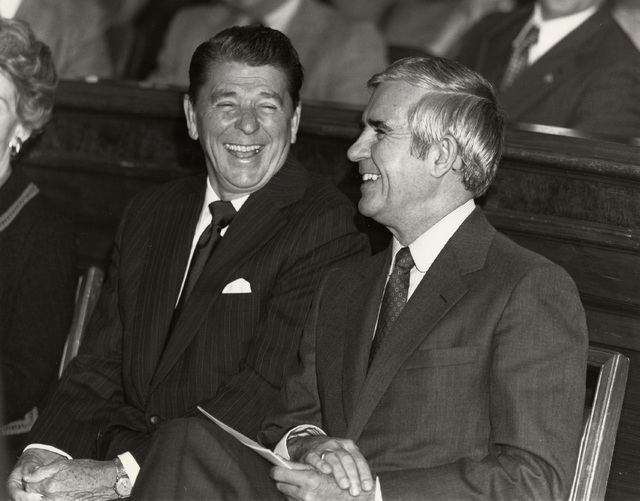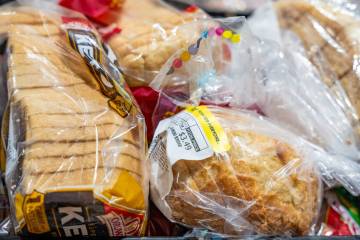Special collection showcases friendship between Paul Laxalt, Ronald Reagan
CARSON CITY — Newly released mementos from revered native Nevada son Paul Laxalt offers a glimpse into presidential politics of a bygone era and the close bond the former governor and U.S. senator forged with former President Ronald Reagan.
A collection of letters, handwritten notes, photographs, audio/visual resources and scrapbooks were made available last week to the public through the University of Nevada, Reno’s Special Collections and Archives.
The collection, called “ ‘The First Friend’ of Ronald Reagan,” is an extraction of personal materials donated by Laxalt to the university. The snippets span the years from 1975 through 1987, a time when Laxalt, the son of an immigrant Basque sheepherder, was national chairman of Reagan’s 1976, 1980 and 1984 presidential campaigns.
Jacquelyn Sundstrand, special collections manuscript and archives librarian, said the materials are a time capsule into the politics and issues of the day.
“It gives a better and broader picture of what sorts of issues people were talking about,” she said.
Some of the items from the collection have been digitized and are available online, but all the materials can be viewed by the public at UNR’s special collections library.
“We are very pleased to be able to make these materials available, especially in what’s turning out to be an election year in which everyone is talking about Reagan,” Sundstrand said.
In the 1976 election, incumbent President Gerald Ford faced criticism for pardoning Richard Nixon, who resigned the presidency two years earlier amid the Watergate scandal.
One outraged constituent wrote to Laxalt, “Under no circumstances will I vote for Gerald Ford,” the first three words underlined three times. He said if Ford received the Republican nomination he would write in Reagan’s name and urge his friends to do so as well.
Another letter, dated Sept. 5, 1975, is from William Loeb, president and publisher of the Manchester Union Leader newspaper. The letter references an editorial on Reagan and urges him to run against Ford.
“From what I read in the papers, you agree with me too, that he shouldn’t delay too long in his announcing,” Loeb wrote to Laxalt, adding that he and his wife planned to be “at home” in Reno that September and looked forward to getting together with the senator.
Loeb concluded, “No one is mad at Ford in New Hampshire but they are not particularly enthusiastic one way or the other about him. A strong personality doing a really good campaign job I think would win.”
Reagan lost to Ford for the GOP nomination, and Democrat Jimmy Carter ascended to the White House.
Four years later, Reagan won the 1980 GOP contest and went on to defeat Carter in the general election. During that campaign, Laxalt penned a note to himself to remind “Ron” to call Billy Graham, the influential evangelical preacher.
“Carter trying to commit him,” the note said. “Had Graham to White House overnight.
“Have reason to believe through Jesse Helms that a call — social in character — would keep him in ‘holding pattern.’”
Reagan wasn’t only fighting the Democratic incumbent in the race to the White House.
In 1979, Sen. Bob Dole of Kansas wrote to Laxalt informing him he would also be announcing his candidacy for the Republican nomination.
“I am aware of your current commitment to Ronald Reagan’s candidacy, but I would appreciate an opportunity sometime soon to discuss my campaign with you,” Dole said.
Laxalt in reply said he welcomed “keeping in touch.” He ended his note with good-natured banter: “Good luck, but not too much!”
Besides politics, the collection provides insight into the friendship Laxalt and Reagan shared, a relationship that took root when they worked on Lake Tahoe and western issues as Republican governors of Nevada and California in the late 1960s and early ‘70s.
In a Feb. 12, 1981, note, Reagan thanks Laxalt for a gift. “It’s on my desk _ the beautiful crystal reminder about where the ‘Bucharoo’ does stop,” Reagan wrote.
“If I ever do forget — hit me over the head with it.”
Neena Laxalt, the senator’s youngest daughter, said she and her brother John worked with the UNR archivists to identify people in photographs and help chronicle materials.
“It’s been a fun experience to go through all the papers and the pictures, be reminded of those days and see how much he enjoyed being in the thick of the action,” Neena Laxalt said of her father, now 93. “Yet never did it change who he was.”
Laxalt donated his personal papers to UNR after he left the Senate in 1987. Sundstrand said the collection now made public is just a small portion of the 800 boxes of materials kept at the university.
Organizing the materials was finally made possible, she said, with a $33,000 grant received last year from the U.S. Institute of Museum and Library Services through the Nevada State Library and Archives.
The funding allowed the library to hire a project archivist, Edan Strekal, to compile the treasures within the Reagan time frame.
Contact Sandra Chereb at schereb@reviewjournal.com or 775-461-3821. On Twitter: @SandraChereb

















